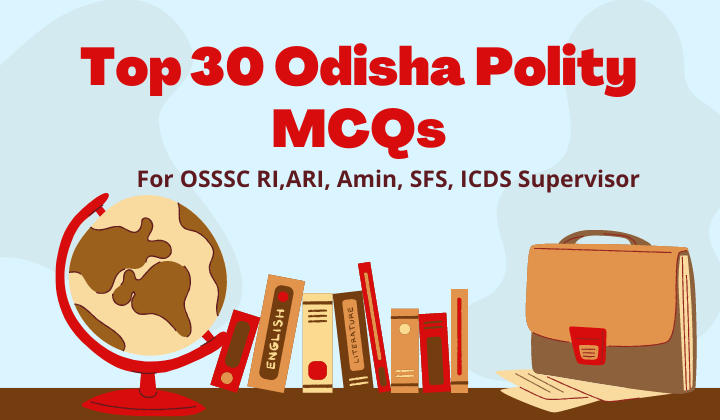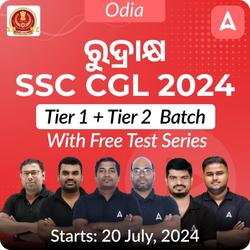As candidates prepare for OSSSC (Odisha Sub-ordinate Staff Selection Commission) examinations, including roles such as RI (Revenue Inspector), ARI (Assistant Revenue Inspector), Amin, SFS (Statistical Field Surveyor), and ICDS (Integrated Child Development Services) Supervisor, an understanding of Odisha’s polity becomes paramount. Encapsulating the essence of Odisha’s political landscape, here are 30 multiple-choice questions (MCQs) meticulously crafted to navigate aspirants through the labyrinth of Odisha’s governance structure. From constitutional provisions to administrative protocols, these questions offer a comprehensive glimpse into the foundational pillars of Odisha’s polity, empowering candidates to navigate the OSSSC examinations with confidence and proficiency. As they embark on their quest to serve the state with diligence and dedication, let these MCQs serve as guiding beacons, illuminating the path towards a deeper comprehension of Odisha’s polity and governance dynamics.
Top 30 Polity of Odisha MCQs For OSSSC RI,ARI, Amin, SFS, ICDS Supervisor
- According to the Indian Constitution, under which Article must there be a separate High Court established in every state of India?
(a) Article 214
(b) Article 226
(c) Article 227
(d) Article 32
Ans. (a) Article 214 - Before the establishment of the Odisha High Court, which High Court had jurisdiction over Odisha along with Bihar in 1912?
(a) Bombay High Court
(b) Calcutta High Court
(c) Madras High Court
(d) Allahabad High Court
Ans. (b) Calcutta High Court - Under which section of the Government of India Act, 1915, was Odisha placed under the jurisdiction of the Patna High Court?
(a) Section 213
(b) Section 214
(c) Section 113
(d) Section 229
Ans. (c) Section 113 - On which date did the Patna High Court hold its first sitting at Cuttack?
(a) 1st April, 1936
(b) 26th July, 1948
(c) 9th February, 1916
(d) 18th May, 1916
Ans. (d) 18th May, 1916 - When was Odisha made a separate province?
(a) 1st April, 1936
(b) 26th July, 1948
(c) 9th February, 1916
(d) 18th May, 1916
Ans. (a) 1st April, 1936 - On what date was the Odisha High Court formally inaugurated?
(a) 1st April, 1936
(b) 26th July, 1948
(c) 9th February, 1916
(d) 18th May, 1916
Ans. (b) 26th July, 1948 - Under which Article of the Constitution does the High Court have the power to issue writs for the restoration of Fundamental Rights?
(a) Article 214
(b) Article 226
(c) Article 227
(d) Article 32
Ans. (b) Article 226 - What type of jurisdiction allows High Courts to hear matters of admiralty, probate, matrimonial, and contempt of court cases?
(a) Appellate Jurisdiction
(b) Original Jurisdiction
(c) Supervisory Jurisdiction
(d) Federal Jurisdiction
Ans. (b) Original Jurisdiction - Under which Article does the High Court have the power of superintendence over all courts and tribunals except those dealing with armed forces?
(a) Article 214
(b) Article 226
(c) Article 227
(d) Article 32
Ans. (c) Article 227 - If the High Court withdraws a case from a subordinate court that involves a substantial question of law as to the interpretation of the Constitution, what can it do?
(a) Only dispose of the case
(b) Only return the case to the subordinate court without any judgement
(c) Dispose of the case or determine the question of law and return the case to the subordinate court with its judgement
(d) Transfer the case to the Supreme Court
Ans. (c) Dispose of the case or determine the question of law and return the case to the subordinate court with its judgement - Which Constitutional Amendment mandates the establishment of Panchayati Raj Institutions as per the recommendations of the Balwant Rai Mehta Committee, 1958?
(a) 42nd Amendment
(b) 73rd Amendment
(c) 86th Amendment
(d) 91st Amendment
Ans. (b) 73rd Amendment - In which year was the three-tier system of Panchayati Raj Institutions (PRIs) established in Odisha?
(a) 1958
(b) 1961
(c) 1994
(d) 1997
Ans. (b) 1961 - What are the three tiers of Panchayati Raj Institutions in Odisha?
(a) District Council, Block Committee, Village Council
(b) Zila Parishad, Panchayat Samiti, Gram Panchayat
(c) State Council, Block Council, Village Assembly
(d) District Assembly, Taluk Panchayat, Village Panchayat
Ans. (b) Zila Parishad, Panchayat Samiti, Gram Panchayat - Which state was the first to conduct elections according to the Provisions of Panchayats (Extension to Scheduled Areas) Act (PESA) of 1996?
(a) Rajasthan
(b) Maharashtra
(c) Odisha
(d) Gujarat
Ans. (c) Odisha - What unique feature is mandated in the Panchayati Raj System in Odisha regarding the roles of Chairperson and Vice-Chairperson?
(a) Both must be from the same party
(b) Both must belong to SC/ST community
(c) Either the Chairperson or the Vice-Chairperson must be a woman
(d) Both must have prior experience in government service
Ans. (c) Either the Chairperson or the Vice-Chairperson must be a woman - In what year did the Odisha Assembly pass the bills providing 33% reservation for women, including SC and ST women, in Panchayats?
(a) 1991
(b) 1994
(c) 1997
(d) 2011
Ans. (a) 1991 - To what percentage was the quota for women in Panchayats increased by the Odisha Panchayat Laws (Amendment) Bill, 2011?
(a) 33%
(b) 40%
(c) 45%
(d) 50%
Ans. (d) 50% - How many Zila Parishads are there in Odisha?
(a) 20
(b) 25
(c) 30
(d) 35
Ans. (c) 30 - Who is the Chief Executive Officer (CEO) of the Panchayat Samiti?
(a) Sarpanch
(b) Chairperson
(c) Block Development Officer (BDO)
(d) District Collector
Ans. (c) Block Development Officer (BDO) - How many Gram Panchayats are there in Odisha according to the Panchayati Raj & Drinking Water Department?
(a) 5000
(b) 6000
(c) 6798
(d) 7000
Ans. (c) 6798 - When was the Odisha State Vigilance created?
(a) 1944
(b) 1950
(c) 1957
(d) 1961
Ans: (a) 1944 - Under which department does the Odisha State Vigilance function?
(a) Finance Department
(b) General Administration Department
(c) Public Service Commission
(d) State Election Commission
Ans: (b) General Administration Department - When was the Odisha Public Service Commission (OPSC) constituted?
(a) 1944
(b) 1949
(c) 1957
(d) 1961
Ans: (b) 1949 - How many members were there in the Odisha Public Service Commission at the time of its creation?
(a) Two
(b) Three
(c) Four
(d) Five
Ans: (b) Three - When did the State Election Commission of Odisha come into existence?
(a) 1987
(b) 1994
(c) 1997
(d) 2000
Ans: (b) 1994 - In which year was the first General Election to Panchayati Raj Institutions (PRIs) held after the constitution of the State Election Commission?
(a) 1987
(b) 1994
(c) 1997
(d) 2000
Ans: (c) 1997 - When did the Odisha Human Rights Commission become formally operational?
(a) 2000
(b) 2001
(c) 2002
(d) 2003
Ans: (d) 2003 - Who was the first chairperson of the Odisha Human Rights Commission?
(a) Justice DP Mohapatra
(b) Justice BN Patnaik
(c) Justice AK Sinha
(d) Justice SK Das
Ans: (a) Justice DP Mohapatra - Where are the headquarters of the Odisha Human Rights Commission situated?
(a) Cuttack
(b) Sambalpur
(c) Bhubaneswar
(d) Berhampur
Ans: (c) Bhubaneswar - Which department is responsible for the management of finances of the State Government of Odisha?
(a) State Vigilance Directorate
(b) Odisha Public Service Commission
(c) Finance Department
(d) State Election Commission
Ans: (c) Finance Department
















